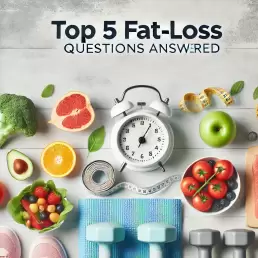Your Fat-Loss Questions Answered.
When it comes to fat loss, there’s no shortage of opinions, plans, and advice floating around. It’s easy to get overwhelmed, especially if you’re short on time and energy. But the truth is, most fat-loss journeys boil down to a handful of core questions. Let’s cut through the noise and get to the answers—practical, no-BS, and grounded in science.
1. What’s the Best Diet for Fat Loss?
The best diet is the one you can actually stick to. Research shows that adherence is the key to long-term success, whether you’re following low-carb, keto, or intermittent fasting. The common denominator? A calorie deficit—eating fewer calories than you burn.
Here’s what matters most:
-
Protein focus: Aim for 0.8–1.2 grams of protein per pound of body weight. Protein helps you feel fuller for longer and preserves muscle as you lose fat.
-
Whole foods: Build your meals around minimally processed foods. They’re more satisfying and nutrient-dense than ultra-processed options.
-
Flexibility: Allow room for the foods you enjoy. Restriction often leads to bingeing, but a flexible approach keeps you consistent.
The takeaway? Find a plan that works for your lifestyle and priorities. It doesn’t have to be perfect—it just has to be sustainable and a way of eating that you actually enjoy.
2. How Much Should I Exercise to Lose Fat?
Exercise is a tool to support fat loss, but it’s not the main driver—your diet is. That said, it plays a critical role in maintaining muscle and overall health.
Here’s the breakdown:
-
Strength training: Lift weights 2–4 times a week. Resistance training helps you preserve muscle, which keeps your metabolism from slowing down as you lose fat.
-
Cardio: Add 150–300 minutes of moderate-intensity cardio weekly (or equivalent high-intensity work). It’s great for heart health and burning extra calories.
-
NEAT (Non-Exercise Activity Thermogenesis): Daily movement like walking, cleaning, or fidgeting adds up. Hitting 8,000–10,000 steps a day can make a big difference.
The goal isn’t to exercise more—it’s to exercise smarter. Combine strength, cardio, and daily movement for a balanced approach.
3. How Do I Handle Cravings and Hunger on a Diet?
Cravings and hunger are normal when you’re in a calorie deficit, but they don’t have to derail you. Here’s how to stay in control:
-
Protein and fiber: Both keep you full longer. Protein reduces hunger hormones, and fiber slows digestion. Think chicken, eggs, veggies, and oats.
-
High-volume foods: Fill up on foods with fewer calories per bite, like salads, soups, and water-rich fruits and veggies.
-
Stay hydrated: Thirst is often mistaken for hunger. Drink 2–3 liters of water daily, especially if you’re active.
-
Plan your meals: Sticking to a regular eating schedule can prevent mindless snacking.
-
Keep treats in the mix: Cutting out your favorite foods completely can backfire. A small portion here and there won’t ruin your progress.
Hunger is part of the process, but smart planning can make it manageable.
4. Why Am I Not Losing Weight Even Though I’m Eating Healthy?
“Healthy” doesn’t always mean “low-calorie.” Foods like nuts, avocados, and whole grains are nutritious but calorie-dense. If you’re not losing weight, here’s what to check:
-
Portion sizes: Even healthy foods can lead to weight gain if eaten in excess. Use a food scale or track your intake for clarity.
-
Hidden calories: Oils, dressings, and sauces can add up quickly. Be mindful of these extras.
-
Stress and sleep: High cortisol levels from stress can lead to fat storage, especially around your middle. Lack of sleep disrupts hunger hormones, making you crave more food.
-
Your deficit shrinking: As you lose weight, your body burns fewer calories. Adjust your intake or increase activity to keep the deficit going.
If you’re not seeing progress, refine your approach and track your results. Small tweaks can have a big impact.
5. How Do I Stay Motivated During My Fat-Loss Journey?
Motivation is great for getting started, but it’s discipline and habits that keep you going. Here’s how to stay on track:
-
Set clear goals: Focus on what you want and why it matters. Break big goals into smaller, manageable steps.
-
Track progress beyond the scale: Look for wins like better energy, strength, endurance, or how your clothes fit.
-
Celebrate milestones: Reward yourself for sticking to the plan. New workout gear or a night out can keep you feeling good about the process.
-
Find support: Whether it’s a coach, a workout buddy, or an online community, accountability helps.
-
Focus on the process: It’s not about perfection; it’s about showing up every day. Small wins compound over time.
